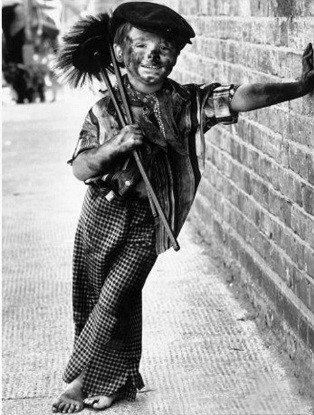What did a chimney sweep do in Victorian times?
What did a chimney sweep do in Victorian times?
Chimney sweeps in Victorian times had the critical responsibility of ensuring that chimneys in homes, factories, and various other structures remained safe and functional. This required them to perform a physically demanding and often hazardous job. Chimney sweeps would venture into chimneys, armed with brushes and scrapers, to remove the accumulated soot, ash, and creosote. Their goal was to prevent chimney fires and the release of toxic gases into living spaces, such as carbon monoxide.
The interior of chimneys could be cramped, pitch-dark, and coated with thick layers of soot and tar-like creosote, making the work both uncomfortable and dangerous. The risk of burns from hot embers and sharp objects within the chimney, as well as respiratory issues from inhaling soot, made this a challenging occupation.
Chimney sweeps played a crucial role in maintaining the safety and hygiene of the urban environment during the Victorian era. Their work helped protect homes and lives from the dangers associated with poorly maintained chimneys.
What are some facts about the Victorian chimney sweep?
The apprenticeship system was a prevalent and defining feature of the chimney sweep trade during the Victorian era. Many chimney sweeps, especially young ones, were not independent workers but apprentices who learned the trade from experienced chimney sweep masters. These young apprentices, often referred to as “climbing boys,” faced difficult and challenging conditions.
Climbing boys were typically children, and they were frequently orphans or came from impoverished families. Due to their vulnerable social and economic status, they were often placed in apprenticeships as chimney sweeps. These young apprentices were expected to assist the master chimney sweep in various tasks, including climbing inside chimneys to perform the necessary cleaning and maintenance.
The life of a climbing boy was arduous and dangerous. They were exposed to the risks of burns, respiratory problems, and physical injuries due to the cramped and dirty chimneys they had to navigate. Some climbing boys even got stuck in chimneys, and the work often led to deformities. This exploitative and hazardous system faced increasing criticism as the Victorian era progressed, leading to reforms aimed at improving the welfare of child chimney sweeps.
Dangers of the Job
Chimney sweeping in Victorian times was one of the most perilous and physically demanding occupations, and the dangers associated with the job were widespread and significant. The primary peril came from climbing inside soot-laden and often narrow chimneys to clean them. The following were some of the major dangers faced by chimney sweeps:
- Respiratory Problems: Inhaling the fine soot and ash particles over time often led to respiratory issues, including “chimney sweep’s cancer” (a form of scrotal cancer) and other lung diseases. The airborne particles could cause chronic coughing, wheezing, and reduced lung function.
- Burns: The inside of chimneys could contain hot embers and sharp objects, leading to burns and injuries to the hands, face, and body. Burns were a constant threat to the chimney sweeps, especially the climbing boys who were smaller and more vulnerable.
- Physical Injuries: Navigating cramped and dark chimneys posed a risk of physical injuries such as bruises, cuts, and fractures. Climbing boys were particularly susceptible to these injuries.
- Getting Stuck: There were instances of climbing boys getting lodged within chimneys, leading to rescue operations to free them. These situations were life-threatening and terrifying.
- Deformities: The physically demanding nature of the job could result in deformities over time, affecting the physical development of young climbing boys.
Despite the inherent dangers, chimney sweeps continued to perform their vital role in maintaining safe and functional chimneys, even as society gradually became more aware of the health and safety risks associated with the trade.
How much money did a chimney sweep earn in Victorian times?
Earnings for chimney sweeps in Victorian times were modest, and for many, especially climbing boys, they were extremely low. The wages varied based on several factors including the location, the specific services provided, and the skill of the chimney sweep. However, the overall picture was one of financial hardship.
Climbing boys, who were child apprentices, received meager compensation. These young apprentices were often orphans or children from destitute families. The chimney sweep masters, who employed them, were notorious for exploiting their vulnerable status, paying them very little for the perilous and physically demanding work they were required to do.
In addition to their low pay, chimney sweeps often had to endure harsh and irregular working conditions. Their hours were long and grueling, and the work itself was dirty and dangerous.
It’s important to note that these conditions were a reflection of the broader economic and social disparities of the Victorian era. The exploitation of child labor was a common issue in various industries, not just chimney sweeping. As societal awareness grew and labor laws began to change in the mid-19th century, there were gradual improvements in the treatment and compensation of chimney sweeps.
When did they stop using children as chimney sweeps?
During the Victorian era, the use of children as chimney sweeps began to decline due to evolving social attitudes, increased awareness of the harsh working conditions, and a growing recognition of the need to protect young workers. One significant piece of legislation aimed at addressing the exploitation and dangers faced by climbing boys was the Chimney Sweepers Act of 1875 in the United Kingdom.
The Chimney Sweepers Act introduced several important regulations to improve the safety and welfare of young chimney sweeps. It included provisions such as:
- Minimum Age Requirement: The act specified a minimum age for chimney sweeps, ensuring that children had to be at least 16 years old before they could work as apprentices.
- Health and Safety Regulations: The law outlined safety standards for climbing boys, including the provision of protective clothing and regular health check-ups.
- Limitation of Climbing Inside Chimneys: The act restricted the age at which young apprentices could climb inside chimneys. This helped protect the youngest and most vulnerable children from the most dangerous aspects of the job.
- Education Requirements: The Chimney Sweepers Act also mandated that climbing boys receive a basic education during their apprenticeships.
The act marked a significant step towards the protection of child laborers in the chimney sweep trade. Although the exploitation of children in this hazardous occupation continued for some time, the reforms initiated during the Victorian era contributed to the eventual decline of child chimney sweeps.
Did girls do chimney sweeping?
While the majority of chimney sweeps in Victorian times were boys, there were instances of girls working in this trade, although it was far less common. Gender norms and societal expectations of the era often dictated that certain jobs were more suitable for one gender over the other. However, in cases of extreme poverty or familial circumstances, girls could end up working as chimney sweeps.
Girls who pursued chimney sweeping faced the same challenges and dangers as their male counterparts. They, too, had to navigate the cramped and soot-filled chimneys, and they were at risk of respiratory problems, burns, and physical injuries. The work was physically demanding and hazardous, regardless of gender.
In some instances, girls may have been less visible in the trade due to societal norms that encouraged them to take on different roles. However, it’s essential to recognize that the use of children, both boys and girls, in such dangerous and exploitative occupations was a broader social issue of the time.
As the Victorian era progressed, there was a growing awareness of the need to protect and provide better opportunities for all children, regardless of their gender, which contributed to the decline of child chimney sweeps. Reforms and legislation aimed at child labor eventually led to improvements in the welfare of young workers, regardless of their gender.
How many hours did child chimney sweeps work?
Chimney sweeps, especially climbing boys, endured long and grueling working hours during the Victorian era. The nature of the job, which involved climbing inside dirty and dark chimneys, demanded irregular and physically demanding labor.
Climbing boys often had to begin their work very early in the morning, as the cleaning of chimneys was typically done before the fires were lit to heat homes or industrial facilities. This meant they had to start their workday well before dawn, and their work hours could extend throughout the day.
The hours spent inside chimneys were irregular, depending on the number of chimneys to be cleaned and the specific needs of each job. These young apprentices were frequently called upon to work in less-than-ideal conditions, even in inclement weather, to ensure that chimneys remained clear and safe for use.
The physical demands of the job were substantial. Navigating the tight and dirty chimneys was exhausting, and the risk of injury and illness added to the arduous nature of the work. Despite these harsh conditions, chimney sweeps, both adult and child, continued to perform their vital role in maintaining safe and functional chimneys throughout the Victorian era.
By the end of the Victorian era, societal reforms and legislative changes were starting to improve the conditions for chimney sweeps, with a focus on safety and professionalism. This marked a significant shift towards a more humane approach to the occupation and the protection of its workers.






